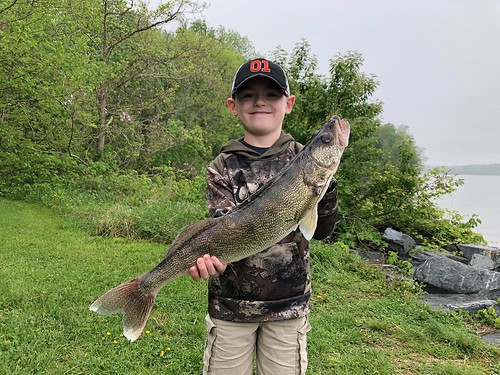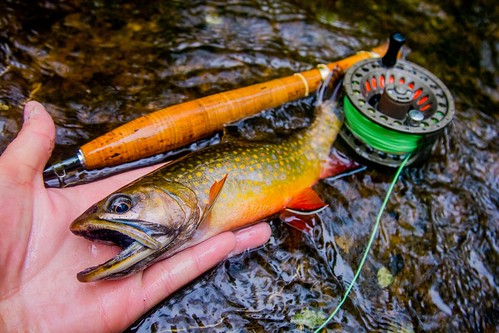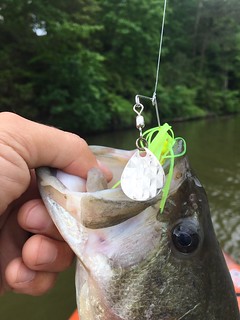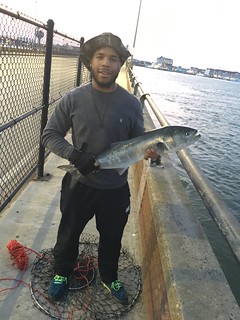Maryland Fishing Report – May 15
While recent rains caused swollen streams and rivers and left everything a bit soggy, the weather for the coming weekend is predicted to be sunny and warm – and it should be a wonderful time to be outside with family and friends. There are several youth fishing opportunities called fishing rodeos where kids line up along grassy community ponds and soak a worm under a bobber with dreams of fishing trophies and the excitement of catching fish.
This is a great opportunity for families and if you’re not sure what to do, there are always plenty of volunteers on hand to help. Our website lists upcoming events by county so you can find one near you.
The cool weather and rain last week temporarily halted steady increases in Chesapeake Bay water temperatures. However, with warmer weather expected for the upcoming week, bay waters should warm back up to the upper 60s. In most bay location, anglers will find adequate oxygen from the surface to bottom for gamefish. However, to avoid low oxygen conditions in the deep channel waters from the Bay Bridge down to the Virginia state line, avoid fishing deeper than 30 feet.
As recorded at the real-time National Oceanic and Atmospheric Administration and Maryland Department of Natural Resources buoys, bay water temperatures have cooled slightly from all the recent rain. For the middle-to-upper bay — from Annapolis north — water temperatures are holding near the low to mid 60s. For the middle-to-lower bay, the surface temperature is holding in the mid-60s while the bottom temperatures are stable at the high 50s. Choptank River area water temperatures are also holding at the mid-60s. For the Potomac River, at Little Falls, surface water temperatures are stable at 70 degrees while downriver at the mouth, Lewisetta is slightly cooler at 65 degrees. At this time of the year, surface waters are warmer than most bottom waters.
Expect reduced water clarity in and near most rivers as a result of the recent rains. Expect elevated flows from the Susquehanna, Potomac and most other rivers and streams due to recent rains farther up in the watershed. There will be above average tidal currents all week as a result of the full moon May 19.
For the full weekly fishing conditions summary and more detailed and up-to-date fishing conditions in your area of the bay, be sure to check out Click Before You Cast.

The waters near the Conowingo Dam are always full of surprises – like the one young Neil Pierce certainly got when he caught this large walleye while fishing for hickory shad. Photo by Michael Pierce
The upper bay will feel the effects of recent rains for at least another week, which means fishing in stained waters and dodging floating debris. The Conowingo Dam now has many spill gates open. Beginning May 16 anglers in the Susquehanna Flats area will be allowed to keep one striped bass between 19 inches and 26 inches per day. Those fishing in the upper bay region below the Hart-Miller Island-Tolchester boundary line will have a daily limit f two fish between 19 inches and 28 inches, or one fish above and one below the 28-inch mark.
Anglers are encouraged to check the department’s online striped bass regulation map to understand where the defining lines are.
When the striped bass regulations change on May 16, more fishermen will start chumming or chunking in the upper bay at Love Point and Podickory Point channel edges. As stained water conditions prevail, this may be a good tactic. A mix of channel and blue catfish will be a large part of what they find taking their baits, if they are allowed to settle to the bottom of the chum slick. Fresh cut menhaden baits will be the most popular bait. Anglers are reminded that non-offset circle hooks must be used in all Chesapeake Bay tidal waters while chumming, chunking or live-lining with any kind of live fish.
Light-tackle jigging will be a popular way to target striped bass along channel edges at Love Point, the steep channel edge at the mouth of the Magothy River down past Podickory, as well as the sewer pipe near the Bay Bridge and its piers. Large soft plastic jigs with large eyes on the jig head have been real producers for this type of fishing. Those trolling will place smaller bucktails and swimshads in their trolling spreads.
Fishing for white perch in the tidal rivers continues to offer plenty of fun and hopefully the river or creek you want to fish is not too stained. The tidal rivers and creeks on the eastern side of the bay tend to be in better shape. There are plenty of catfish to catch on cut bait, clam snouts, chicken livers or gizzards.

Travis Long holds up a healthy looking striped bass for a picture before releasing it. Photo courtesy of Travis Long
Those seeking to catch a trophy-sized striped bass saw their fortunes increase last week, which is generally on schedule with the exodus of post-spawn striped bass from the spawning rivers. Although their numbers are a bit tempered this week, there is still a good chance to encounter one of these magnificent fish as they exit the region.
The steep edges of the shipping channel from Bloody Point and the outside edge of Hacketts Bar down to Calvert Cliffs and the CP Buoy have been good locations. Most of the action is coming close to the surface and extremely early in the morning. Tandem rigged large parachutes or bucktails dressed with sassy shads in white and chartreuse have been the lures of choice.
Beginning May 16, anglers can keep striped bass at two per day for fish measuring 19 inches to 28 inches, and or one each in the 19-28-inch slot and one fish longer than 28 inches. Many will begin to put smaller bucktails or swimshads in their trolling spreads rigged in tandem or behind umbrella rigs.
The focus for many will now shift to school-sized striped bass that can be found suspended along channel edges. Light-tackle jigging with large soft plastic jigs will be the most popular way to target them in the steep channel edges at Hacketts, Thomas Point and most anywhere fish can be spotted on depth finders.
Chumming and chunking will be a fun way to fish for striped bass and many of the traditional locations will see boats anchored up this weekend. A mix of blue and channel catfish will be major players in any chum slick due to extremely depressed salinities. Any bait settling to the bottom will be fair game. Fresh cut menhaden will be the most popular bait and fishermen need to remember that they must use non-offset circle hooks. Our website helps explain things to those unaccustomed to fishing with circle hooks.
Fishing for white perch continues to be good and most are reporting a larger grade of white perch this year. Grass shrimp and bloodworms top the list for bait choices. In the mornings and evenings white perch can also be caught in shallower waters on beetle spins, spinners or small rattletraps near shoreline structure. Sunken wood, submerged rock jetties and dock piers are good places to fish. Bill Burton Fishing Pier State Park along with the Matapeake and Romancoke fishing piers are very good places to fish for a mix of white perch and catfish.
As it usually does, this region offers the best opportunities to intercept large post-spawn striped bass exiting the spawning rivers. Many anglers report the best action is at dawn, often before all lines can be deployed in the first 30 minutes of fishing. Some of the most consistent action has been occurring at Cove Point, Point Lookout and Smith Point.
Trolling spreads will undergo changes after May 16 when smaller striped bass will be fair game. Medium-sized bucktails and swimshads will be added to trolling spreads, either rigged in tandem or behind umbrella rigs.
Most likely some will try their hand at chumming or chunking this week at traditional channel edges. Before setting up, searching channel edges with depth finders for suspended fish will be in order. Due to low salinity values in the region, blue catfish will be very prominent in chum slicks waiting for any bait that drifts into the lower depths of a chum slick.
Fishing for white perch has been very good in the tidal creeks and rivers on both sides of the bay. Some are using bottom rigs baited with pieces of bloodworm or grass shrimp; others are having fun casting small spinners and beetle spins for their perch. Many are remarking about the quality size of the perch being caught.
Over on the eastern side, there has been plenty of fun action casting in the shallower areas for small but feisty striped bass. Many anglers are casting swimbaits and topwater lures and enjoying the catch-and-release action. More than a few speckled trout and red drum are also being caught. A highlight on the red drum side of things is that most of the red drum are falling inside the 18-inch to 27-inch slot.
Recreational crabbers who love getting out and laying a trotline or collapsible crab traps are slowly venturing out to their favorite grounds, shaking the bugs out of their boats and equipment. Most are describing their success at catching crabs as a big “goose egg” to a slow pick. The best crabbing is occurring on the lower Eastern Shore where someone who knows what they’re doing can manage nearly a full bushel in an outing. Deeper waters in the range of 15 feet or more is the sweet spot and chicken necks seem to be doing fine as bait.
Recent rains have many rivers at flood stage in many regions of the state, particularly in the central and western regions. The upper Potomac River is dangerous right now but will most likely level out later on this week. Streams will empty out fairly quickly and are now in good shape.
When the upper Potomac calms down, there should be good fishing for smallmouth bass along current breaks and submerged ledges. Small crankbaits and soft plastic jigs tend to be favorite choices for baits. At Deep Creek Lake largemouth bass are still in a pre-spawn stage of aggressive feeding so working transition depths with spinnerbaits and jerkbaits is a great idea. Rocky points, sunken wood and deep grass are great places to look for smallmouth bass. Drifting minnows, small crankbaits and jigs are good choices for baits.
Stocking crews continue to be busy this week placing trout in the various trout management waters throughout the state. The focus on trout stockings has been moving to the central and western regions as water temperatures warm. Fly fishermen are enjoying wonderful fishing as some hatches begin to occur, including sulphurs and caddis in the central and western regions.
Fishing for largemouth bass in much of Maryland is about as good as it gets right now, except for some stained waters in some areas and perhaps high water. Grass beds have filled out so there is plenty of shallow water cover in most ponds, reservoirs and tidal waters. The fun topwater action has started and with water temperatures still fairly cool the morning action lasts longer into late morning and starts earlier in the evenings. In most regions of the state, largemouth bass are in a post-spawn mode, so the large female bass are feeding aggressively. Casting spinnerbaits and swimbaits along grass edges is a good bet, especially on sunny days. Buzzbaits tend to be a good choice when fishing over the grass. Crankbaits, grubs and soft plastics can be excellent choices to fish drop-off edges and deeper sunken wood.
In the tidal Potomac, working the milfoil beds with topwater lures or dropping stick worms with little or no weight down through the grass is a proven tactic this time of the year. The Spoils and Mallows Bay have been a great places to fish. The area is also a great place to catch crappie on minnows and a bobber and a mix of yellow and white perch are being caught by casting beetle spins.
The tidal rivers on the Eastern Shore are offering excellent fishing for largemouth bass and crappie. Casting spinnerbaits along the outside edges of spatterdock fields on a falling tide is usually productive. Buzzbaits are a good choice to fish the spatterdock and grass during higher water.
Northern snakeheads will be a big part of the mix when fishing buzzbaits back in grass or spatterdock. The bite has slowed down as the fish are spawning and in many waters they are protecting their brood that has hatched. They are aggressively protective, so dragging a buzzbait through their no trespassing zone will often elicit a violent strike.
There are some new northern snakehead regulations being proposed regarding what defines a legally killed fish. The purpose is to make it easier on fishermen. The proposed regulation would make cutting off the head, gutting, cutting gill arches or filleting all acceptable legal methods of killing northern snakeheads. The proposed regulations are in the comment phase so one can read them and make a comment by email from our website.
The inshore fishing at Ocean City is off to a great start. Surf fishermen are catching a nice mix of bluefish, black drum, kingfish and blowfish. The bluefish range from one pound to large eight- to ten-pounders; they are being caught on cut bait or by casting metal in the surf. Striped bass are being caught on cut baits of menhaden or mullet and more than a few have been large. The kingfish are being caught on bloodworms and blowfish on squid. The black drum are being caught on clams or sand fleas.
At the inlet and Route 50 Bridge there has been a bluefish blitz during a flood tide. Casting Got-Cha plugs, bucktails, metal or drifting cut bait has been the most popular ways to catch a limit of bluefish. Most are the wonderful eating size of about a pound or so, but some very large ones have also been caught. Striped bass are also part of the mix. Tautog are being caught on pieces of green crab and sand fleas at the South Jetty and along bulkheads. Flounder continue to move through the inlet into the back bay areas.
Flounder fishing in the channels leading away from the inlet has been very good when clear water conditions prevail. A falling tide tends to offer the best fishing. Squid or minnows have been good baits and many are fishing with large white Gulp type baits to target the largest flounder. Bluefish and striped bass can be found in the back bay waters by casting swimbaits, bucktails or Got-Cha plugs in the channel areas.
Outside the inlet and on the shoal areas those trolling for bluefish have been doing very well. The inshore wreck and reef sites are holding tautog which is closing May 15, but the much-anticipated sea bass season is also now open. Good luck to all!
There are some new proposed regulations that will be of interest to coastal fishermen in the coming year. The first will model our sheepshead creel limit after Virginia’s, which is four fish per day. Another will mandate that circle hooks be used when fishing for sharks. Both are proposed regulations and are in the comment period, so check them out on our website and send a comment by email if you wish.
Bluefin tuna are being caught out near the Baltimore Canyon while trolling and limit catches have been the norm this week. For offshore anglers looking for bluefin tuna, NOAA has posted adjusted regulations. In the angling category for private boats (HMS Angling category-permitted vessels), the adjusted limit per vessel per day or trip, is two school bluefin tuna 27 inches to just under 47 inches, and one large school bluefin tuna 47 inches to just under 73 inches, and the effective period for the adjusted retention limit will be May 11 through Dec. 31. Anglers should be aware that the bluefin regulations differ slightly for charter and head boats, this is also posted on the same NOAA website for adjusted regulations.
Finally, with bluefin tuna already here and pelagic sharks arriving soon, anglers are reminded to turn in their catch cards for both bluefin tuna and sharks. All landed sharks (except spiny dogfish) are required to be reported in Maryland. For more details and instructions, see our website.
“So if escapism is a reason for angling-then the escape is to reality. The sense of freedom that we enjoy in the outdoors is, after all, a normal reaction to a more rational environment. ” — A.J. McClaine
Maryland Fishing Report is written and compiled by Keith Lockwood, Maryland Department of Natural Resources fisheries biologist.
Click Before You Cast is written by Tidewater Ecosystem Assessment Director Tom Parham.
This report is now available on your Amazon Echo device — just ask Alexa to “open Maryland Fishing Report.”





